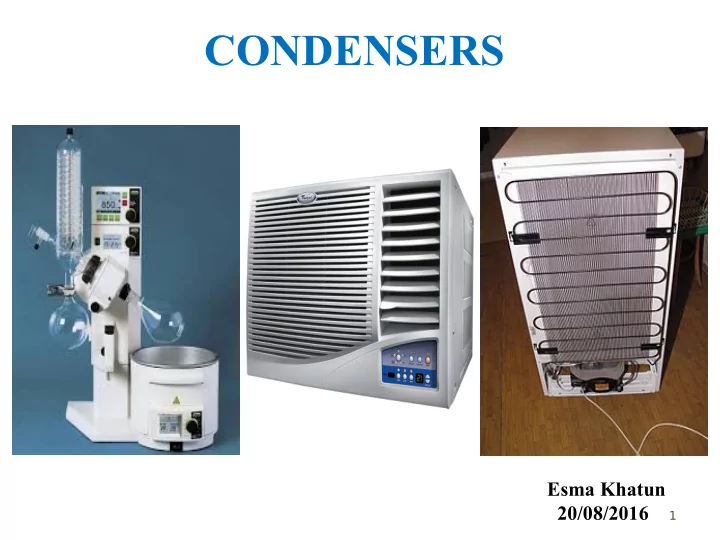

CONDENSERS Esma Khatun 20/08/2016 1
Introduction Condensers and evaporators are basically heat exchangers in which the refrigerant undergoes a phase change. In condensers the refrigerant vapor condenses by rejecting heat to an external fluid, which acts as a heat sink. In evaporators, the liquid refrigerant evaporates by extracting heat from an external fluid (low temperature heat source). 2
Thermodynamic analysis of the system At point 1 in the diagram, the circulating refrigerant enters the compressor in a saturated state. From point 1 to point 2, the refrigerant is isentropically compressed (i.e., compressed at constant entropy) and exits the compressor in a superheated state. The process 2-3’ is a de-superheating process. Process 3’-3 is the condensation process. Process 3-4 is a sensible, sub cooling process, during which the refrigerant temperature drops. Refrigeration cycle on T-s diagram Process 4-5 is the adiabatic flash evaporation process which is isenthalpic. 3
Condensers 1) Air cooled condensers a) Natural convection type b) Forced convection type 2) Water cooled condensers a) Double pipe or tube-in-tube type b) Shell-and-coil type c) Shell-and-tube type 3) Evaporative condensers 4
Natural convection type In natural convection type, heat transfer from the condenser is by buoyancy induced natural convection and radiation. Due to small air flow and low radiation heat transfer, the combined heat transfer coefficient in these condensers is small. As a result a relatively large condensing surface is required to reject a given amount of heat. Example - household refrigerators and freezers. 5
Forced convection type In forced convection type condensers, the circulation of air over the condenser surface is maintained by using a fan or a blower. These condensers normally use fins on air- side for good heat transfer. The fins can be either plate type or annular type. Forced convection type condensers are commonly used in window air conditioners, water coolers and packaged air conditioning plants. 6
Water cooled condensers: Double pipe (tube-in-tube) type Shell-and-coil type condenser condenser 7
A two-pass, shell-and-tube type condenser 8
Evaporative condenser In evaporative condensers, both air and water are used to extract heat from the condensing refrigerant. In these condensers, the water is sprayed from top part on a bank of tubes carrying the refrigerant and air is induced upwards. There is a thin water film around the condenser tubes from which evaporative cooling takes place. The heat transfer coefficient for evaporative cooling is very large. Hence, the refrigeration system can be operated at low condensing temperatures (about 11 to13 K above the wet bulb temperature of air). 9
Analysis of condensers The total heat rejected in the condenser, Q C is given by: m is the mass flow rate of refrigerant h 2 , h 4 are the inlet and exit enthalpies of refrigerant m ext is the mass flow rate of the external fluid C p, ext is an average specific heat of the external fluid T ext,o and T ext,i are the inlet and exit temperatures of the external fluid U is the overall heat transfer coefficient A is the heat transfer area of the condenser ΔT m is mean temperature difference between refrigerant and external fluid 10
Mean temperature difference: If we assume condensation throughout the length of the condenser and also assume the pressure drop to be negligible, then the mean temperature difference is given by the Log Mean Temperature Difference (LMTD): T ext,o and T ext,i are the inlet and outlet temperatures of the external fluid T c is the condensing temperature. 11
Condenser Heat Rejection Ratio (HRR): = = For a fixed condenser temperature, as the evaporator temperature decreases the COP decreases and heat rejection ratio increases. For fixed evaporator temperature as the condenser temperature increases the COP decreases hence the heat rejection ratio increases. 12
13
THANK YOU 14
Recommend
More recommend